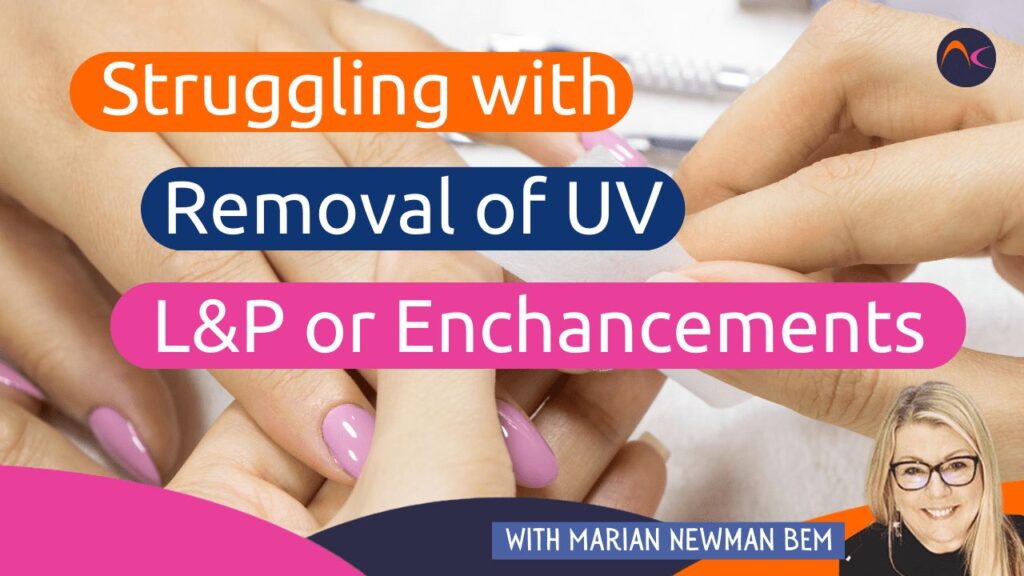Otra persona aplicó el sistema de uñas
Many seem to struggle with removals of UV and L&P overlays or enhancements. Especially if they have been applied by someone else.
There is really no reason to refuse to remove someones else’s work, not if you understand the science behind it. There is a good chance you could gain a new and loyal client.
La mayoría de los sistemas de uñas pueden remojarse
There are many different systems being used today but it is only a ‘hard gel’ that will not soak off and needs to be buffed off for removal. All other systems, including UV gel, L&P, sistemas de inmersión (unless those with a hard UV gel), fibreglass, full cover tips etc. can be soaked off using acetone based products.
So what’s on your nails?
A título orientativo:
UV gel based systems will soak off in 10-20 minutes. If there is no change in the coatings after this time then it could be a hard gel version that needs buffing to remove. Clients do not always know what is on their nails.
L&P will soak off in around 30 minutes. If it is one with an MMA monomer, then this will take several hours and will need buffing off (a very long job in itself)
Many UV gel polish systems use a hard gel top coat to help protect the colour from damage. The client may know this but unless you know for sure, it is often worth lightly buffing the surface to break it up and allow for the solvent to penetrate.
Métodos de eliminación
- Remojo en acetona
Prepare un recipiente resistente al disolvente con acetona suficiente para cubrir las uñas (no más). Después de pulir la superficie, pida al cliente que introduzca las uñas en el disolvente y las deje allí al menos 10 minutos para empezar,
Make sure the coating is starting to lift at this time. If not it may be a hard gel and will not soak off
Acelerar el proceso
Toma 2 cuencos, uno lo suficientemente grande para que quepan 10 dedos y otro más grande.
Coloca acetona en el cuenco pequeño, como en el caso anterior, y agua caliente en el grande. Coloca el pequeño en el grande y pide a tu cliente que introduzca los dedos en el disolvente.
Cúbrelo todo con una toalla para evitar que se escapen los vapores.
Precaución
Asegúrate de que los cuencos están sobre una mesa plana y no corren peligro de volcarse.
Don’t use boiling water as this could make the solvent too hot and avoid burns if accidentally tipped over.
2. Retirada del envoltorio
This is a similar method to the above but doesn’t use an open bowl. Instead, it uses tin foil to secure a cotton pad tightly on the nail that has been soaked in acetone.
Se puede comprar papel de aluminio precortado, pero también sirve papel de cocina cortado en tamaños adecuados.
Empapa la almohadilla de algodón (la mitad o la mitad del grosor servirá) en acetona, colócala sobre la uña y envuélvela bien con el papel de aluminio. Dobla el extremo y asegúrate de que quede bien ajustado para que el disolvente no pueda salir y la almohadilla quede sujeta a la uña.
After around 10 mins, unwrap to see how the removal is progressing. It is likely to need some more solvent added to the pad and, as above if the coating isn’t moving, it may be a non-soak-off coating. Re-wrap until coatings are all removed.
Acelerar el proceso
Ponerse las manos en manoplas térmicas acelerará enormemente el proceso (pero asegúrese de que el forro está protegido de la acetona con un forro o guante sobre toda la mano.
Una almohadilla térmica también funciona, sobre todo en invierno, cuando las manos de los clientes están frías.
Pprecaución
Si utiliza equipos eléctricos, asegúrese de que son seguros mediante la prueba PAT (consulte este blog).
3. Removedores calentados
Relativamente nuevos para el sector son los calentadores eléctricos diseñados para la retirada. (Doug Schoon los ha revisado y los considera seguros si se utilizan de forma responsable).
Tienen un recipiente para el disolvente que se encuentra en una unidad calentada.
Se cubre con una tapa que tiene agujeros para los dedos con un sello para evitar que se escapen los vapores.
Con este método, los dedos no tienen que tocar el disolvente y los vapores de debajo de la tapa empaparán los revestimientos.
NB, vapours are actually the chemical. Much like steam from boiling water is still water.
Acelerar el proceso
Tenga 2 unidades para que ambas manos puedan estar en remojo al mismo tiempo.
Precaución
Pruebe primero la unidad usted mismo. Algunas pueden calentarse bastante, a veces demasiado, por lo que los dedos sólo tienen que atravesar la tapa muy poco.
Asegúrese de que la unidad está estable y no puede volcarse ni salirse de la mesa.
La parte científica
Cada material tiene una cierta cantidad de característica permeable (permite la penetración de moléculas) ¡¡¡incluso el metal!!!
The structure of the molecules of every material will have gaps of varying sizes between them. Depending on the size and shape of the spaces and the shape and size of another material (e.g solvents, water, oil etc.)
Soak-off coatings have a molecular structure that allows for small molecules, such as suitable nail oils and acetone to penetrate and break the polymer bonds that formed during curing.
Los geles duros tienen una estructura mucho más cerrada que no permite la fácil penetración de un disolvente (la acetona tiene la molécula más pequeña, por eso es el mejor removedor).
Hybrid gels are pure gels plus solvents. The solvents evaporate from the coating and as they do this they create a ‘tunnel’ where the solvent works it way up to the surface. This allows for very easy acetone penetration and is the fastest to remove.
Cyanoacrylates have a linear molecular structure allowing for easy penetration.
Dip systems with either a UV gel or a cyan acrylate can be harder to remove as the powder fills up a lot of the spaces in the polymer structure so making penetration difficult
The least amount of spaces does make for a stronger structure which is why many prefer hard gels for sculpting and enhancements. Hybrids and ‘soak offs’ are not as strong but this has a good compromise as being much faster to remove and less skin and nail exposure to drying solvents.
El L&P puede penetrar debido a su estructura polimerizada aunque tenga enlaces cruzados avanzados. Por eso es importante la aplicación diaria de aceite para uñas, ya que rellena los espacios y la mantiene flexible.
Cada tipo de producto tiene una razón de uso en función de lo que necesite el cliente y del estado de sus uñas.
Precauciones generales
If your clients skin is dry or they don’t like the whiteness after contact with acetone, then oil can be applied for some protection. This can easily wash off so a balm or a product like Vaseline can be painted on to give more protection, but only on the skin and not the nail!
When the nails have been removed from the solvent, NEVER scrape off any remaining coating as the nail plate will be soft and very easily damaged. To remove any remaining product, just soak a cotton pad in acetone and rub the product off.
Acetone is a volatile solvent and evaporated easily, releasing the chemical into the air. Make sure you dispose of all remaining solvent, foils etc. safely and responsibly!
Absorbe el líquido restante con una toalla de papel y colócalo en un contenedor cubierto y forrado. O colócalo en una zona exterior segura (donde no puedan acceder niños ni animales) y deja que se evapore.
No vierta nunca agua por el fregadero o el lavabo, ya que muchas tuberías son de plástico y los vapores pueden acumularse en las alcantarillas.
La mudanza no tiene por qué ser un procedimiento difícil o estresante. Sólo hay que tener en cuenta los tiempos.
Si usted ofrece la retirada gratuita si ha aplicado los revestimientos, incluya el tiempo en su tarifa. La retirada del trabajo de otros debe cobrarse en consecuencia. Si hace reservas telefónicas, hay muchas cosas que pueden determinarse en ese momento (no es tan fácil para las reservas en línea).


